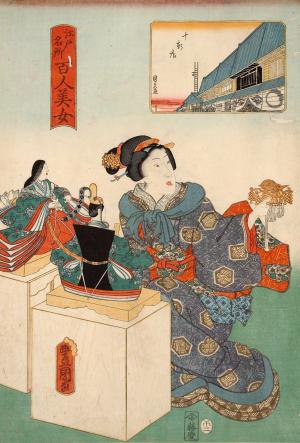Famous Places in Edo, Hundred Beautiful Women, Jikkendana (Edo Meisho Hyaku-nin Bijo Jikkendana)
Painted by Utagawa Toyokuni III and Utagawa Kunihisa II 1858 (Ansei 5) Tokyo Shiryō Collection 025-C1-13
This picture depicts a lady holding the hina doll's crown in front of the dairibina, dolls representing the Emperor and Empress, and the scenery of Jikkendana is depicted in the picture in the frame. In Jikkendana, there are lines of shops selling dairibina and bald dolls for the Momo Festival of the third month on the lunar calendar and warrior figurines and carp banners for the Tango Festival of the fifth month of the lunar calendar.
Jikkendana was located where Nihonbashi Muromachi in Chuo Ward is today and it is said to be so called because 10 shops (jikken) lined both sides of the street.
Throughout Edo, hina markets that sold hina dolls (a set of dolls for the hinamatsuri festival consisting traditionally of members of the Imperial court) were held in places such as Owaricho, Asakusa Kaya-cho and Komagome, but it was Jikkendana that was most successful.
During around the Meiwa years (1964-1772), the doll maker Shugetsu Hara made the kokin-bina dolls. It is said that these kokin-bina dolls were related to the hina dolls of today. In the Edo period, there was such a diversity of dolls created that the shogunate banned the making of dolls that were excessively extravagant.


